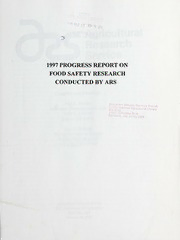
Progress report on food safety research conducted by ARS PDF
Preview Progress report on food safety research conducted by ARS
Historic, Archive Document Do not assume content reflects current scientific knowledge, policies, or practices. \ 3 PROGRESS REPORT ON 1997 FOOD SAFETY RESEARCH CONDUCTED BY ARS Document Delivery Services Srench N^S,'cga"°na' A9"="!«"al Library" 10301 Baltimore Blvd Beltsvills, MD 20705-2351 Agricultural Research Service Compiled and Edited by: Kip E. Panter Poisonous Plant Research Lab 1150 E. 1400 N. UT Logan, 84341 Jane F. Robens National Program Leader BARC-West BIdg. #5 MD Beltsville, 20705 Agricultural Research Service U.S. DepartmentofAgriculture MD Beltsville, October 10, 1997 1997ProgressReportonFoodSafetyResearchConductedbyARS EXECUTIVE SUMMARY The safety oftheNation's food supply is one ofthe most important issues to American consumers. Consumers are demanding a safety assurancesystem forraising, harvesting, processing, transportation, handling and storage offood emphasizing preventionoffoodborne pathogens. This need to assure food safety was recognized bytheFederal government inthe Food Safety Initiative (FSI) of1997 whichcalls forexpanded food safety researchand risk assessment efforts. The goal ofthe FSI is to preventfoodcontamination from productionto consumption (Farm to Table Continuum); the FSI emphasizes the following areas ofrisk assessment and food safety research: 1) Develop and validate pathogen exposure assessment models; 2) Developmentofrapid, cost-effective tests for the presence in foods ofpathogens K suchas Salmonella, Cryptosporidium, Coli0157:H7 and others; 3) Enhance understanding ofhow pathogens become resistantto food-preservationtechniques and antibioticsand4) Develop technologies for prevention and control ofpathogens, suchas newmethods of decontamination ofmeat, poultry, seafood, fresh produce and eggs. Agricultural Research Service (ARS) has the appropriate physical facilities, stateofthe art laboratory equipmentand the scientific expertise andexperience to make significantcontributions to all ofthe above importantaspects offood safetyresearch and riskassessment. Thisreport summarizes ARS research progress onFood Safety ofanimal products in 1997. It does notyet includethe ARS studies to control pathogens onfruits and vegetables. The research is categorized into 4 general areas: I. Control ofFoodborne Pathogens in Live Animals; II. Pathogen Control During Slaughter and Processing (Inspection Technology); III. Post-slaughter Pathogen Modeling and Control; IV. ResidueDetection and Chemical Analysis. I. Control ofFoodborne Pathogens in LiveAnimal: Food safety ofanimal products begins withmanagement practices, including herd and flock healthprograms to preventdisease and control infection in the live animal. ARS research to control human pathogens in live animals includesvaccine development, competitive exclusion cultures, and breeding and selectionof resistantanimals. This researchbenefits greatly from the longARS experience with zoonotic pathogens in large animals. ARS has developedtwo competitiveexclusion cultures (CEC) to control Salmonella on commercial broiler farms andthe technologieshave beentransferredto CRADA partners and are awaiting Food and Drug Administration (FDA) approval. The use of similarproducts to control Salmonella in turkeys is being investigated. Another CEC has been developed to controlSalmonella in swine and an investigational newanimal drug applicationhas been submitted to the FDA. Certainphagetypes (PT) ofSalmonella enteritidis (SE) are routinely isolated from contaminated eggs, hen-house environments, rodents and from infectedpeople. However, PT4, which is aparticularly virulent SE, and has been historically associated with incidence ofillness inpeople in othercountries, has nowbeen isolated in the U.S. ARS identified the outer i ExecutiveSummary membrane characteristics unique to PT4 SE. This assay can be used by FSIS and diagnostic labs to groupall SE isolates into PT4 and non-PT4 lineages. As part ofaNational Antimicrobial Susceptibility Monitoring SystemSalmonella isolates obtained from cattle, swine, chickens, turkeys, swine feed, ground product, exotics, dogs and cats were tested for susceptibility to 16 antimicrobials. All isolates were susceptible to amikacin, cepotaxime, and ciprofloxacin. Approximately 34% and 28% ofthe isolates were resistantto tetracycline and sulfamethoxazole, respectively, while 13%ofthe isolates were resistant to both ampicillin and ticarcillin. Lessthan 9% resistance was observed forall otherantimicrobics. A T-cell line has been developed which is capable ofproducing largequantities of Salmonella enteritidis(SE)-immune lymphokine (VILK). Two patents have been allowed fora T-cell line to produce VILK and for in ovo administration ofVILK forprevention ofdisease. A CRADA has been formed forthe development and use ofVILK. A continuous-culturemodel ofrumen micro flora has been developed to predict growthand survivability ofE. coli0157:H7 in fasted and well fed cattle. E. coli 0157:H7 was demonstrated to colonize the intestinesofcattle and to be shed in the feces. Newborn calves may be very susceptibleto the infection and develop severe diarrheawhile weaned calves are moreresistant to the disease. Virulence factors ofE. coli 0157:H7 and other Shiga toxin-producing E. colihave been identified and both intimin and Shigatoxin were shown to have arole incolonization in weaned calves butonly intimin wasrequired forpathogenesis in newborn calves. Vaccinating cattle forE. coli 0157:H7 may be possible, however, this may be difficult because shigatoxins were shownto be immunosuppressive. Methods are being developed forsubtyping ofCampylobacter Strains. A neworal vaccine to prevent Campylobacter colonizationofchickens is being tested. Farm audits are being conducted in cooperationwithAPHIS to determine trichinae infection A rates and to certify farms free ofinfection. national prevalence assessment oftrichinellosis in hogs is being conductedwhichwill be used in decisions ofcontrol and risk assessment. II. Pathogen control duringslaughterand processing (Inspection Technology): Slaughterand processing is akey link in the food safety chain. Improved understanding of foodborne pathogentransmission, control steps in prevention, sanitation, and processing technology are necessaryelements toprevent contamination, cross contaminationand wide spread foodborne illness. ARS research in this areaincludes the isolationofover 15 different serovars ofSalmonella fromhogpen floors and hog hauling trailers. Thus, washing and sanitizing hog hauling trailers and holdingpens has the potential to reduce contamination atthe slaughterplant. Feed withdrawal in broilers priorto slaughter increased infection rates oftheircrops with Salmonella and Campylobacter. Since crop removal and subsequent rupture ofcontaminated crops is a major source ofcarcass contamination, feed withdrawal priorto broilerprocessing represents a preharvest critical control point. Feed withdrawal used to induce molt to stimulate egg laying in aging flocks may decrease resistance to SE and increase risk to the nearly 180 million hens in systemsusing this practice. Methods, such as lactose indrinking waterto restore SE resistance in molting hens, are being investigated. ii
